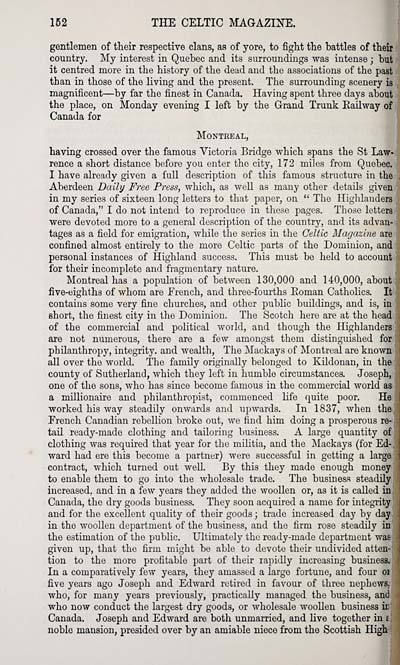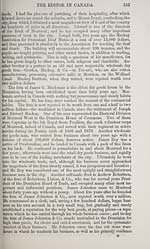Blair Collection > Celtic magazine > Volume 5
(162)
Download files
Complete book:
Individual page:
Thumbnail gallery: Grid view | List view

162 THE CELTIC MAGAZINE. |
gentlemen of their respective clans, as of yore, to figlit tlie battles of their Jj
country. ISIy interest in Quebec and its surroundings was intense ; but '|
it centred more in the history of the dead and the associations of the past ''.]
than in those of the living and the present. The surrounding scenery is j]
magnificent — by far the finest in Canada. Having spent three days about J
the place, on Monday evening I left by the Grand Trunk Railway of
Canada for
Montreal,
having crossed over the famous Victoria Bridge which spans the St Law- !)
rence a short distance before you enter the city, 172 miles from Quebec. -
I have already given a full description of this famous structure in the .
Aberdeen Daily Free Press, which, as well as many other details given
in my series of sixteen long letters to that paper, on " The Highlanders ,.
of Canada," I do not intend to reproduce in these pages. Those letters '|
were devoted more to a general description of the country, and its advan- i»
tages as a field for emigration, while the series in the Celtic Magazine are ■'•:
confined almost entirely to the more Celtic parts of the Dominion, and %
personal instances of Highland success. This must be held to account 't
for their incomplete and fragmentary nature. ';;
Montreal has a population of between 130,000 and 140,000, about |,)
five-eighths of whom are French, and three-fourths Eoman Catholics. It ■
contains some very fijie churches, and other public buildings, and is, in !!i
short, the finest city in the Dominion. The Scotch here are at the head i
of the commercial and political woild, and though the Highlanders \ '■.
are not numerous, there are a few amongst them distinguished for j
philanthropy, integrity, and wealth. The Mackays of Montreal are known i
all over the world. The family originally belonged to Kildonan, in the ,
county of Sutherland, which they left in humble circumstances. Joseph, ,
one of the sons, who has since become famous in the commercial world as ;
a millionaire and philanthropist, commenced life quite poor. He I
worked his way steadily onwards and upwards. In 1837, when the ;
French Canadian rebellion broke out, we find him doing a prosperous re- i
tail ready-made clothing and tailoring business. A large quantity of ;
clothing was required that year for the militia, and the Mackays (for Ed- j
ward had ere this become a partner) were successful in getting a large i
contract, which turned out well. By this they made enough money
to enable them to go into the wholesale trade. The business steadily
increased, and in a few years they added the woollen or, as it is called in
Canada, the dry goods business. They soon acquired a name for integrity
and for the excellent quality of their goods \ trade increased day by day
in the woollen department of the business, and the firm rose steadily in
the estimation of the public. Ultimately the ready-made department was
given up, that the firm might be able to devote their undivided atten-
tion to the more profitable part of their rapidly increasing business, :
In a comparatively few years, they amassed a largo fortune, and four oi
five years ago Joseph and Edward retired in favour of three nephews,
who, for many years previously, practically managed the business, and i
who now conduct the largest dry goods, or wholesale wooUen business ir ' \
Canada. Joseph and Edward are both unmarried, and live together in £ '
noble mansion, presided over by an amiable niece from the Scottish High- i
gentlemen of their respective clans, as of yore, to figlit tlie battles of their Jj
country. ISIy interest in Quebec and its surroundings was intense ; but '|
it centred more in the history of the dead and the associations of the past ''.]
than in those of the living and the present. The surrounding scenery is j]
magnificent — by far the finest in Canada. Having spent three days about J
the place, on Monday evening I left by the Grand Trunk Railway of
Canada for
Montreal,
having crossed over the famous Victoria Bridge which spans the St Law- !)
rence a short distance before you enter the city, 172 miles from Quebec. -
I have already given a full description of this famous structure in the .
Aberdeen Daily Free Press, which, as well as many other details given
in my series of sixteen long letters to that paper, on " The Highlanders ,.
of Canada," I do not intend to reproduce in these pages. Those letters '|
were devoted more to a general description of the country, and its advan- i»
tages as a field for emigration, while the series in the Celtic Magazine are ■'•:
confined almost entirely to the more Celtic parts of the Dominion, and %
personal instances of Highland success. This must be held to account 't
for their incomplete and fragmentary nature. ';;
Montreal has a population of between 130,000 and 140,000, about |,)
five-eighths of whom are French, and three-fourths Eoman Catholics. It ■
contains some very fijie churches, and other public buildings, and is, in !!i
short, the finest city in the Dominion. The Scotch here are at the head i
of the commercial and political woild, and though the Highlanders \ '■.
are not numerous, there are a few amongst them distinguished for j
philanthropy, integrity, and wealth. The Mackays of Montreal are known i
all over the world. The family originally belonged to Kildonan, in the ,
county of Sutherland, which they left in humble circumstances. Joseph, ,
one of the sons, who has since become famous in the commercial world as ;
a millionaire and philanthropist, commenced life quite poor. He I
worked his way steadily onwards and upwards. In 1837, when the ;
French Canadian rebellion broke out, we find him doing a prosperous re- i
tail ready-made clothing and tailoring business. A large quantity of ;
clothing was required that year for the militia, and the Mackays (for Ed- j
ward had ere this become a partner) were successful in getting a large i
contract, which turned out well. By this they made enough money
to enable them to go into the wholesale trade. The business steadily
increased, and in a few years they added the woollen or, as it is called in
Canada, the dry goods business. They soon acquired a name for integrity
and for the excellent quality of their goods \ trade increased day by day
in the woollen department of the business, and the firm rose steadily in
the estimation of the public. Ultimately the ready-made department was
given up, that the firm might be able to devote their undivided atten-
tion to the more profitable part of their rapidly increasing business, :
In a comparatively few years, they amassed a largo fortune, and four oi
five years ago Joseph and Edward retired in favour of three nephews,
who, for many years previously, practically managed the business, and i
who now conduct the largest dry goods, or wholesale wooUen business ir ' \
Canada. Joseph and Edward are both unmarried, and live together in £ '
noble mansion, presided over by an amiable niece from the Scottish High- i
Set display mode to: Large image | Transcription
Images and transcriptions on this page, including medium image downloads, may be used under the Creative Commons Attribution 4.0 International Licence unless otherwise stated. ![]()
| Early Gaelic Book Collections > Blair Collection > Celtic magazine > Volume 5 > (162) |
|---|
| Permanent URL | https://digital.nls.uk/76450834 |
|---|
| Description | Volume V, 1880. |
|---|---|
| Shelfmark | Blair.6 |
| Attribution and copyright: |
|
| Description | A selection of books from a collection of more than 500 titles, mostly on religious and literary topics. Also includes some material dealing with other Celtic languages and societies. Collection created towards the end of the 19th century by Lady Evelyn Stewart Murray. |
|---|
| Description | Selected items from five 'Special and Named Printed Collections'. Includes books in Gaelic and other Celtic languages, works about the Gaels, their languages, literature, culture and history. |
|---|

